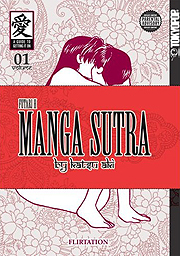Manga Friday: I’ve Got a Yen
This week I have three books from the fine folks at Yen Press. All of them are the second volume in their respective series, and I’ve only read the first book of one of them…which means it’s time for me to be confused yet again.
(Don’t worry – I’m well used to it by now.)

Black God, Vol. 2
Story by Dall-Young Lim; Art by Sung-Wao Park
Yen Press, 2008, $10.99
This is yet another series about a young man (Keita) bonded to a gorgeous supernatural girl (Kuro) who doesn’t have much knowledge of the modern world – apparently, he lost his arm in the first book, and she saved his life and bonded permanently with him to get his arm back. (She’s a “mototsumitama,” for those making notes at home. What does that mean? I dunno…)
In a startling reversal, Keita is not a nerdy high school student, but a mid-20s jerk of a videogame designer/programmer. (On the big two-page title spread of the very first story in this book, he’s strangling Kuro awake in the morning because she ruined his life – “ruined” apparently in the sense of “saved him from dying and gave him a connection to vast supernatural hoodoo.”) I think Keita is supposed to be at least mildly attractive to the reader, but I found him a complete ass.
In this book, some of the details of the human-mototsumitama relationship are explained, as Kuro meets another mototsumitama woman, who is bonded to an old man. (Keita’s boyhood friend, the equally cute Akane, also has something to do with the overall plot, but exactly what isn’t clear yet.) And what happens when two super-powered folks meet in a comic book, kids? That’s right – a big fight scene!
The art is clean and detailed, easy to follow for Americans while still being clearly in a manga style. The story is nothing terribly new – psychic battles, girls in their underwear, emotional turmoil – but it moves decently and the dialogue is pretty good. If Keita were anything like an acceptable human being, this could be a solid adventure story.



 It used to be, if you wanted to reach for the comic art form for your sex education you had to send a couple bucks to those want ads in the back of the cheesy magazines for “Comics – the Kind Men Like!” That stuff was a bit distorted; well, in the case of the ones that featured [[[Popeye]]], I’d have to say they were quite a bit distorted.
It used to be, if you wanted to reach for the comic art form for your sex education you had to send a couple bucks to those want ads in the back of the cheesy magazines for “Comics – the Kind Men Like!” That stuff was a bit distorted; well, in the case of the ones that featured [[[Popeye]]], I’d have to say they were quite a bit distorted.




 I’ve long harbored a suspicion about the “Mammoth Books” – you’re familiar with them, right? Big fat reprint anthologies, on a wide range of subjects (fiction and nonfiction, photographic and comics) published by Constable and Robinson in the UK and imported to this side of the pond by the now-defunct Carroll & Graf? – were put together somewhat on the cheap. (This was based on my encounters with their historical reprints, which I kept thinking should be called things like The Mammoth Book of Vampire Stories That Are Out of Copyright.)
I’ve long harbored a suspicion about the “Mammoth Books” – you’re familiar with them, right? Big fat reprint anthologies, on a wide range of subjects (fiction and nonfiction, photographic and comics) published by Constable and Robinson in the UK and imported to this side of the pond by the now-defunct Carroll & Graf? – were put together somewhat on the cheap. (This was based on my encounters with their historical reprints, which I kept thinking should be called things like The Mammoth Book of Vampire Stories That Are Out of Copyright.) We all want to get on the ground floor, but that doesn’t always happen. Sometimes, we find ourselves walking into a movie two reels in, munching popcorn and whispering to each other “And who is that guy?” In honor of those confused moments in all of our lives, this week Manga Friday read Book Two in a short stack of manga series, and tried to figure out what the heck was going on.
We all want to get on the ground floor, but that doesn’t always happen. Sometimes, we find ourselves walking into a movie two reels in, munching popcorn and whispering to each other “And who is that guy?” In honor of those confused moments in all of our lives, this week Manga Friday read Book Two in a short stack of manga series, and tried to figure out what the heck was going on.








